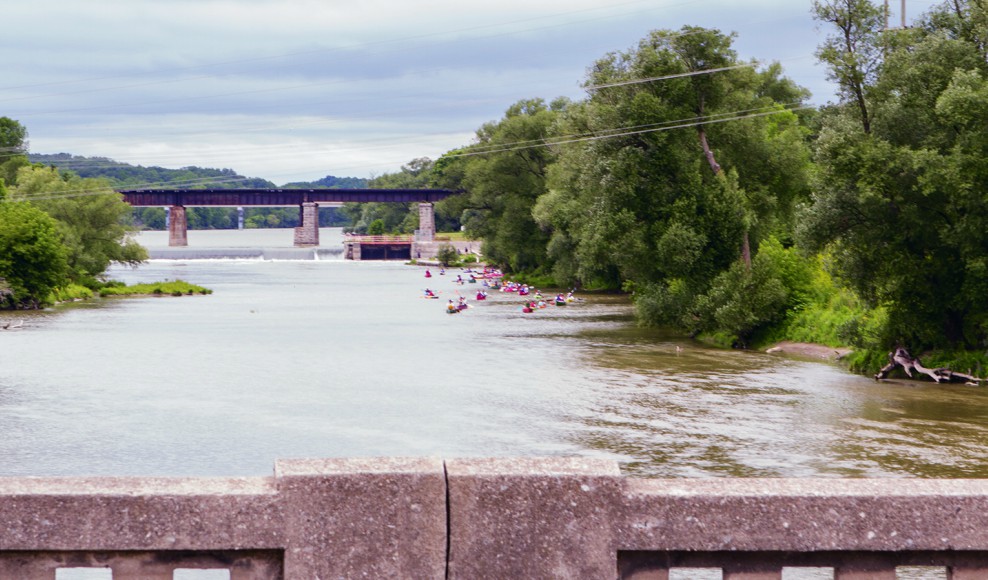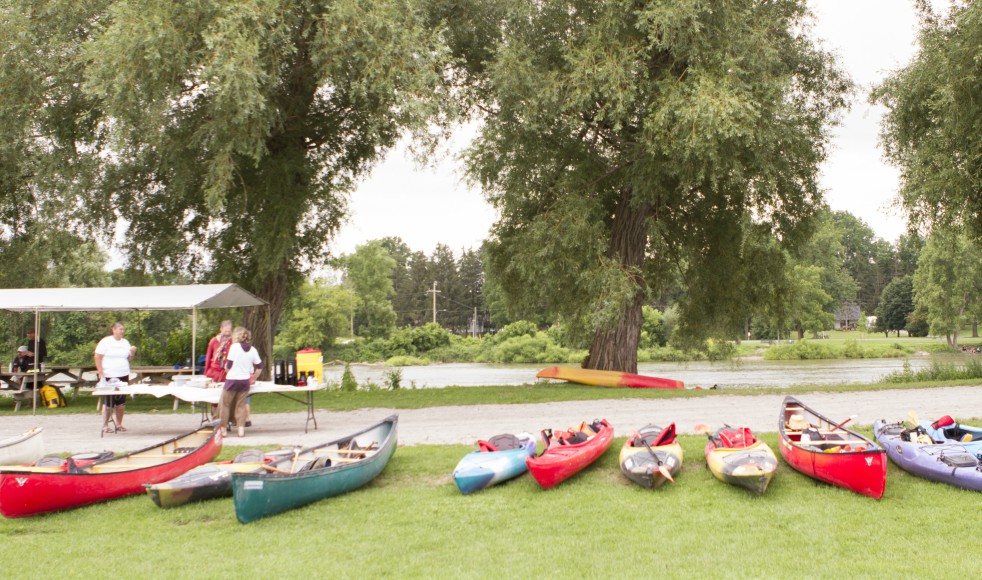Travelling the river of life

The annual Two Row on the Grand paddling journey commemorates the Two Row Wampum, a symbol of co-operation and friendship between Indigenous and non-Indigenous people. / J.D. Howell photo
BY Sonia Verma
March 20, 2018
Two summers ago, social work professor Bonnie Freeman participated in a three-day paddling journey down the Grand River, aimed at promoting understanding and alliances between Indigenous and non-Indigenous peoples. But Freeman and her canoeing partner got some extra insight — when they capsized.
Freeman, who is Algonquin/Mohawk from the Six Nations of the Grand River Territory, had never paddled a canoe until two days earlier, when she took an hour-long canoe lesson. She had invited a colleague — Trish Van Katwyk from the University of Waterloo, also a novice paddler — to join her in the canoe during the Two Row on the Grand paddle.
The pair had a rough time for the first day and a half, trying to keep up with the larger group, before ultimately flipping their canoe.
“It was pivotal point for us — we had been working against each other, and now we realized we each had different but complementary responsibilities within the canoe, and we had to work together, hear and understand. The canoe became a conduit in understanding alliances, a bridge between our two paths.”
The Two Row journey
Freeman has been studying Indigenous journeys across land and water for many years. It was the focus of her doctoral dissertation, and she has participated in several journeys herself.
“Indigenous people take these journeys so they can connect to their culture, healing from the generations of genocide and trauma they have experienced,” she explains.
In 2013, a large group of paddlers travelled down the Hudson River in upstate New York in a renewal of the Two Row wampum, paddling the river in two columns of canoes, one Indigenous and the other non-Indigenous.
The Two Row agreement was made between the Haudenosaunee and Dutch settlers in 1613. The Haudenosaunee recorded it on a wampum belt, with two rows of purple beads signifying the parallel paths of an Indigenous canoe and a European ship. It was an acknowledgment of peace, friendship, and the fact that different beliefs and ways of life can co-exist — both travel the river of life, but neither attempts to steer the other’s craft.
While Freeman didn’t participate in the 2013 Hudson River journey, other community members from Six Nations did. They brought their ideas and experiences back. “They decided to start organizing the Two Row on the Grand River Paddle in 2016, and when I heard about it, I wanted to learn more about it and participate,” she says.
At the time, Freeman was working with scholars and her community, hoping to shape research about a Two Row Research Paradigm. When a Six Nations community researcher suggested putting their theory into action, Freeman approached the organizers of the Two Row on the Grand River paddle to implement a pilot project, and invited Van Katwyk along.

An annual event
After that journey, Two Row on the Grand organizers decided to make it an annual event, and Freeman and Van Katwyk together applied for and received a $64,000 SSHRC Insight Development grant for their project, Testing the Waters: Building Relationships through Reconciliation and a Two Row Research Paradigm.
The project seeks to understand the impact of such journeys and how they affect reconciliation efforts, individuals’ lives and wellbeing, and the formation of relationships, alliances and friendship.
Freeman and Van Katwyk joined the 2017 paddle down the Grand River — paddling, camping and speaking with participants about the physical, emotional, intellectual and spiritual impact the experience had on their lives.
“First-time paddlers shared how alive they felt being on the water and the insight they learned from Haudenosaunee culture,” Freeman says. “For return paddlers, it was about coming back to this beautiful river, meeting up with friends, and more learning.”
Another part of Freeman and Van Katwyk’s project looks at other aspects of the relationship between the Haudenosaunee and their neighbours along the Grand River — Freeman points to ongoing tension in Caledonia. “However, there have been some good things that have happened between Caledonia and Six Nations, too — such as the Children’s Pen Pal initiative from both places. We’re trying to find how people are implementing active ways in understand the Grand River and to build relationships with the Haudenosaunee through reconciliation.”
The next phase of Freeman and Van Katwyk’s research will start this spring and summer, when they plan to gather youth from Six Nations and Elora. They will try to help them understand the history of the Grand River and the importance of the Two Row wampum, and see how that understanding shapes their relationships. At the end, both youth groups will come together for a three-day paddle during Two Row on the Grand River.
“Throughout the research project, we’re going to have the youth document and gather information about their experience and what they have learned, and then we will have the youth share their experience through digital storytelling or an art-based medium.”


